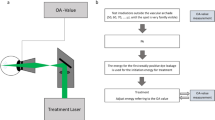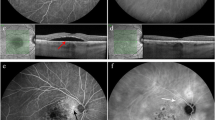Abstract
Purpose
To investigate the prognostic factors on spectral domain optical coherence tomography (SD-OCT) associated with incomplete subretinal fluid (SRF) absorption in treated-naïve eyes with central serous chorioretinopathy (CSC) after the half-dose verteporfin photodynamic therapy (vPDT).
Methods
Patients with CSC who underwent half-dose vPDT with a follow-up period of more than 3 months were included in this retrospective study. Logistic regression was performed to determine the risk factors associated with the SRF persistence at 3 months after the treatment.
Results
A total of 143 patients with 150 eyes were enrolled in this study (102 male and 41 female patients). The rate of complete SRF resolution was 82.7% at 3 months for all cases. The duration of symptoms > 6 months (odds ratio [OR] = 3.135, 95% confidence interval [95% CI] (1.147–8.573), p = 0.026), larger SRF area with base diameter > 3 mm (odds ratio (OR) = 4.051, 95% CI: 1.336–12.284, p = 0.013), and larger flat irregular pigment epithelium detachment (FI-PED) area with base diameter > 1 mm (OR = 3.311, 95% CI: 1.249–8.780, p = 0.016) on OCT B-scans were risk factors for incomplete SRF absorption after half-dose vPDT, while outer nuclear layer (ONL) thickness was not significantly associated with the anatomical outcome (OR = 1.015, 95% CI: 0.995–1.036, p = 0.145).
Conclusion
The duration of symptoms, baseline SRF, and FI-PED base diameter on SD-OCT were important predictors for the anatomical outcome at 3 months after half-dose vPDT. Further studies are needed to establish a better therapeutic strategy for patients with poor response to half-dose vPDT.


Similar content being viewed by others
References
Fok AC, Chan PP, Lam DS, Lai TY (2011) Risk factors for recurrence of serous macular detachment in untreated patients with central serous chorioretinopathy. Ophthalmic Res 46:160–163. https://doi.org/10.1159/000324599
Matet A, Daruich A, Zola M, Behar-Cohen F (2018) Risk factors for recurrences of central serous chorioretinopathy. Retina 38:1403–1414. https://doi.org/10.1097/IAE.0000000000001729
Nathaniel Roybal C, Sledz E, Elshatory Y, Zhang L, Almeida DRP, Chin EK, Critser B, Abramoff MD, Russell SR (2018) Dysfunctional autonomic regulation of the choroid in central serous chorioretinopathy. Retina 38:1205–1210. https://doi.org/10.1097/IAE.0000000000001677
van Rijssen TJ, van Dijk EHC, Yzer S, Ohno-Matsui K, Keunen JEE, Schlingemann RO, Sivaprasad S, Querques G, Downes SM, Fauser S, Hoyng CB, Piccolino FC, Chhablani JK, Lai TYY, Lotery AJ, Larsen M, Holz FG, Freund KB, Yannuzzi LA, Boon CJF (2019) Central serous chorioretinopathy: towards an evidence-based treatment guideline. Prog Retin Eye Res 73:100770. https://doi.org/10.1016/j.preteyeres.2019.07.003
Daruich A, Matet A, Dirani A, Bousquet E, Zhao M, Farman N, Jaisser F, Behar-Cohen F (2015) Central serous chorioretinopathy: recent findings and new physiopathology hypothesis. Prog Retin Eye Res 48:82–118. https://doi.org/10.1016/j.preteyeres.2015.05.003
Colucciello M (2006) Choroidal neovascularization complicating photodynamic therapy for central serous retinopathy. Retina 26:239–242. https://doi.org/10.1097/00006982-200602000-00027
Lee PY, Kim KS, Lee WK (2009) Severe choroidal ischemia following photodynamic therapy for pigment epithelial detachment and chronic central serous chorioretinopathy. Jpn J Ophthalmol 53:52–56. https://doi.org/10.1007/s10384-008-0613-z
Hwang S, Noh H, Kang SW, Kang MC, Lee D, Kim SJ (2020) Choroidal neovascularization secondary to photodynamic therapy for central serous chorioretinopathy: incidence, risk factors, and clinical outcomes. Retina. https://doi.org/10.1097/IAE.0000000000003067
Chan WM, Lai TY, Lai RY, Liu DT, Lam DS (2008) Half-dose verteporfin photodynamic therapy for acute central serous chorioretinopathy: one-year results of a randomized controlled trial. Ophthalmology 115:1756–1765. https://doi.org/10.1016/j.ophtha.2008.04.014
Hu J, Qu J, Li M, Sun G, Piao Z, Liang Z, Yao Y, Sadda S, Zhao M (2021) Optical coherence tomography angiography-guided photodynamic therapy for acute central serous chorioretinopathy. Retina 41:189–198. https://doi.org/10.1097/IAE.0000000000002795
Iovino C, Au A, Chhablani J, Parameswarappa DC, Rasheed MA, Cennamo G, Cennamo G, Montorio D, Ho AC, Xu D, Querques G, Borrelli E, Sacconi R, Pichi F, Woodstock E, Sadda SR, Corradetti G, Boon CJF, van Dijk EHC, Loewenstein A, Zur D, Yoshimi S, Freund KB, Peiretti E, Sarraf D (2020) Choroidal anatomic alterations after photodynamic therapy for chronic central serous chorioretinopathy: a multicenter study. Am J Ophthalmol 217:104–113. https://doi.org/10.1016/j.ajo.2020.04.022
Chung CY, Chan YY, Li KKW (2018) Angiographic and tomographic prognostic factors of chronic central serous chorioretinopathy treated with half-dose photodynamic therapy. Ophthalmologica 240:37–44. https://doi.org/10.1159/000484100
Chan WM, Lai TY, Lai RY, Tang EW, Liu DT, Lam DS (2008) Safety enhanced photodynamic therapy for chronic central serous chorioretinopathy: one-year results of a prospective study. Retina 28:85–93. https://doi.org/10.1097/IAE.0b013e318156777f
Loo RH, Scott IU, Flynn HW Jr, Gass JD, Murray TG, Lewis ML, Rosenfeld PJ, Smiddy WE (2002) Factors associated with reduced visual acuity during long-term follow-up of patients with idiopathic central serous chorioretinopathy. Retina 22:19–24. https://doi.org/10.1097/00006982-200202000-00004
Yu J, Jiang C, Xu G (2019) Correlations between changes in photoreceptor layer and other clinical characteristics in central serous chorioretinopathy. Retina 39:1110–1116. https://doi.org/10.1097/IAE.0000000000002092
Bousquet E, Bonnin S, Mrejen S, Krivosic V, Tadayoni R, Gaudric A (2018) Optical coherence tomography angiography of flat irregular pigment epithelium detachment in chronic central serous chorioretinopathy. Retina 38:629–638. https://doi.org/10.1097/IAE.0000000000001580
Chronopoulos A, Kakkassery V, Strobel MA, Fornoff L, Hattenbach LO (2020) The significance of pigment epithelial detachment in central serous chorioretinopathy. Eur J Ophthalmol:1120672120904670.https://doi.org/10.1177/1120672120904670
Bujarborua D, Chatterjee S, Choudhury A, Bori G, Sarma AK (2005) Fluorescein angiographic features of asymptomatic eyes in central serous chorioretinopathy. Retina 25:422–429. https://doi.org/10.1097/00006982-200506000-00005
Song IS, Shin YU, Lee BR (2012) Time-periodic characteristics in the morphology of idiopathic central serous chorioretinopathy evaluated by volume scan using spectral-domain optical coherence tomography. Am J Ophthalmol 154:366-375 e364. https://doi.org/10.1016/j.ajo.2012.02.031
Sousa K, Viana AR, Pires J, Ferreira C, Queiros L, Falcao M (2019) Outer nuclear layer as the main predictor to anatomic response to half dose photodynamic therapy in chronic central serous retinopathy. J Ophthalmol 2019:5859063. https://doi.org/10.1155/2019/5859063
Yang L, Jonas JB, Wei W (2013) Optical coherence tomography-assisted enhanced depth imaging of central serous chorioretinopathy. Invest Ophthalmol Vis Sci 54:4659–4665. https://doi.org/10.1167/iovs.12-10991
Dansingani KK, Balaratnasingam C, Klufas MA, Sarraf D, Freund KB (2015) Optical coherence tomography angiography of shallow irregular pigment epithelial detachments in pachychoroid spectrum disease. Am J Ophthalmol 160:1243-1254 e1242. https://doi.org/10.1016/j.ajo.2015.08.028
Hwang H, Kim JY, Kim KT, Chae JB, Kim DY (2020) Flat irregular pigment epithelium detachment in central serous chorioretinopathy: a form of pachychoroid neovasculopathy? Retina 40:1724–1733. https://doi.org/10.1097/IAE.0000000000002662
Hage R, Mrejen S, Krivosic V, Quentel G, Tadayoni R, Gaudric A (2015) Flat irregular retinal pigment epithelium detachments in chronic central serous chorioretinopathy and choroidal neovascularization. Am J Ophthalmol 159:890-903 e893. https://doi.org/10.1016/j.ajo.2015.02.002
Liang Z, Qu J, Huang L, Linghu D, Hu J, Jin E, Xu H, Li H, Tao Y, Xu X, Liu G, Li Y, Zhao M (2021) Comparison of the outcomes of photodynamic therapy for central serous chorioretinopathy with or without subfoveal fibrin. Eye (Lond) 35:418–424. https://doi.org/10.1038/s41433-020-0858-4
Yu J, Ye X, Li L, Chang Q, Jiang C (2021) Relationship between photoreceptor layer changes before half-dose photodynamic therapy and functional and anatomic outcomes in central serous chorioretinopathy. Eye (Lond) 35:1002–1010. https://doi.org/10.1038/s41433-020-1018-6
Funding
The study was supported by the capital clinical diagnosis and treatment technology research and demonstration application project of China (Grant Z191100006619029). The funder had no role in the study design, data collection and analysis, decision to publish, or preparation of the manuscript.
Author information
Authors and Affiliations
Contributions
Conceptualization: Mengyang Li and Jinfeng Qu.
Methodology: Jinfeng Qu.
Formal analysis and investigation: Mengyang Li, Jinfeng Qu, and Zhiqiao Liang.
Writing—original draft preparation: Mengyang Li, Jie Hu, and Jiyang Tang.
Writing—review and editing: Enzhong Jin, Yuou Yao, and Mingwei Zhao.
Funding acquisition: Jinfeng Qu.
Resources: Xiaoxin Li and Mingwei Zhao.
Supervision: Xiaoxin Li and Mingwei Zhao.
All authors have read and approved the content and agree to submit for publication in the journal.
Corresponding author
Ethics declarations
Ethics approval
This retrospective study was approved by the Peking University People’s Hospital Review Board and adhered to the tenets of the Declaration of Helsinki and Health Insurance Portability and Accountability Act.
Consent to participate
Written informed consent was obtained from all individual participants included in the study.
Competing interests
The authors declare no competing interests.
Additional information
Publisher's note
Springer Nature remains neutral with regard to jurisdictional claims in published maps and institutional affiliations.
Mengyang Li and Jinfeng Qu contributed equally to the work presented here and should therefore be regarded as equivalent first authors.
Rights and permissions
About this article
Cite this article
Li, M., Qu, J., Liang, Z. et al. Risk factors of persistent subretinal fluid after half-dose photodynamic therapy for treatment-naïve central serous chorioretinopathy. Graefes Arch Clin Exp Ophthalmol 260, 2175–2182 (2022). https://doi.org/10.1007/s00417-021-05531-3
Received:
Revised:
Accepted:
Published:
Issue Date:
DOI: https://doi.org/10.1007/s00417-021-05531-3




